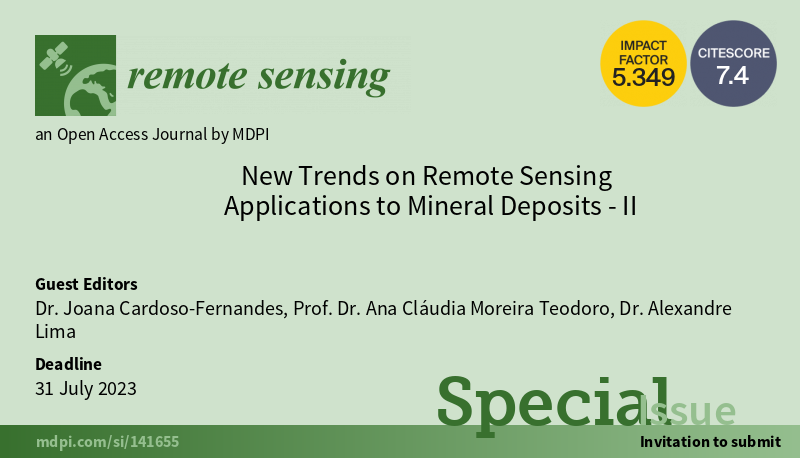
Satellite-based remote sensing has played an important role in the early stages of mineral exploration since the 1970s. For the last four decades, different product types and numerous image processing algorithms have made it possible to target exploration areas all over the world. After the failure of ASTER’s shortwave infrared (SWIR) module, new approaches have been developed, with the commercial satellites WorldView-3 presenting a better compromise between spatial and spectral resolution. Despite lacking a thermal sensor, it has a similar spectral resolution to that of ASTER in the SWIR region. Recently, hyperspectral data have become increasingly used in mineral deposit studies, either in the exploration phase (e.g., using drone-borne sensors) or even during the exploitation phase, with hyperspectral imaging of drill cores (core scanners). Moreover, we are entering a new era of satellite hyperspectral imaging with the Environmental Mapping and Analysis Program (EnMAP) and Precursore Iperspettrale della Missione Applicativa (PRISMA) data. The Hyperspectral Imager Suite (HISUI) onboard the International Space Station (ISS) is another hyperspectral alternative. There can also be expected changes in the application of synthetic aperture radar (SAR) data to mineral deposits with the upcoming Phased Array type L-band Synthetic Aperture Radar-2 (PALSAR-2) data from the Advanced Land Observing Satellite-2 (ALOS-2) mission.
In recent years, we have observed increasing applications to non-traditional geological deposits such as diamond, bauxite, evaporite minerals, lithium, and rare earth elements (REEs), due to current paradigm shifts in global decarbonization and related technological advances that lead to a higher demand for critical raw materials. Simultaneously, we have seen a growing integration of geological/geophysical and remote sensing data, often using non-parametric methods such as machine- and deep-learning algorithms.
Therefore, in this Volume II Special Issue of Remote Sensing, we are looking for innovative remote sensing approaches that make use of new remote sensing data and/or machine- and deep-learning algorithms for non-traditional mineral deposits, welcoming works focusing on multi-data integration. Ultimately, the goal is to publish any research studies that can contribute to the current state of the art, and that may help to assess the challenges and potentials of new applications in the field of geological remote sensing.
Special Issue Editors
Guest Editor
Guest Editor
Guest Editor
Manuscript Submission Information
Manuscripts should be submitted online at www.mdpi.com by registering and logging in to this website. Once you are registered, click here to go to the submission form. Manuscripts can be submitted until the deadline. All submissions that pass pre-check are peer-reviewed. Accepted papers will be published continuously in the journal (as soon as accepted) and will be listed together on the special issue website. Research articles, review articles as well as short communications are invited. For planned papers, a title and short abstract (about 100 words) can be sent to the Editorial Office for announcement on this website.
Submitted manuscripts should not have been published previously, nor be under consideration for publication elsewhere (except conference proceedings papers). All manuscripts are thoroughly refereed through a single-blind peer-review process. A guide for authors and other relevant information for submission of manuscripts is available on the Instructions for Authors page. Remote Sensing is an international peer-reviewed open access semimonthly journal published by MDPI.
Read the message from the guest editors.








